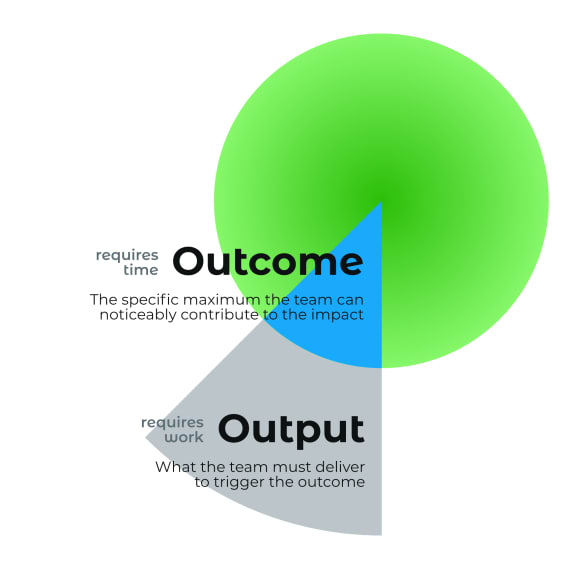Outcome vs. Output
Aug 30, 2021 · 3min read
This is a subchapter of the article IOOI: Put Purpose to Work
It’s easy to mix up Outcome and Output. Here’s why we should care to keep them separated, and practical tips on how to make the distinction.
Chapters
The Value of Differentiating ¶
Why should we make the difference, anyway?
In my opinion, it helps to know when patience is required. We love to celebrate our success immediately even though it’s sometimes unrealistic to achieve it right away. If your team aims at increasing customer satisfaction by 8%, chances are that the team won’t get there over night—even if it has everything at its disposal necessary to make it happen. The team might be working hard right now; the indicator might still lag and show sustainable change only weeks down the line.
Still, there are a few things that are more immediate, and indicate if your team is on the right track. It’s like taking an exam: Before getting any result, or even before taking it, you can determine how well you are/were prepared and how nervous or focused you are/were.
Knowing the difference between your Outcome and Output, you’re able to manage expectations and celebrate your successes appropriately. (We’ve all seen athletes celebrate too early, haven’t we?)
The Difference Between Outcome and Output ¶
Outcome and Output are both something that our team can fully control. The difference is the time it takes to see the result. Whatever your Output is to trigger the Outcome—your audiences, your customers, your community will take some time to absorb and react. And since it takes time, your team needs to be capable to patiently sustain the Outcome.

Example: Client Acquisition ¶
Outcome: “Today, five new clients ordered our service!” The Outcome is a late reaction to what your team did earlier on several occasions.
Output: “Today, I’ve spoken to five potential new clients!” The Output is an action, something immediately visible and tangible (i.e., like meeting minutes or a log entry in your CRM system). Something that becomes meaningful only through the later reaction of your users.
Considerations ¶
When filling out the IOOI Canvas, try to start from the top. Write down whatever comes to mind. If you use sticky notes, you can move them around if you discover that you misplaced them in the beginning.
For Outcome, try to answer three questions: who benefits, how do they benefit, and how can the benefit be measured? Don’t worry if you lack well established indicators. Invent them with your team. It’s OK to start with imperfect ones and improve over time!
If your team’s Outcome can contribute to more than one element of your Impact, map the different Outcomes to the different Impacts. For instance: If your company’s objectives are to increase revenue and to lower costs—and your team contributes to both: Make the exercise of defining audiences, benefits, and indicators for each of the Impact’s elements.
If you’re describing something that will have an immediately lasting effect right after you finished your work, you’re most likely describing your Output. Releasing software or publishing content is Output; whatever the released software or the published content causes in your users is Outcome. Will your new app increase revenue? Will your new strategy change the behaviour of employees?
Chapters

Michael Schmidle
Founder of PrioMind. Start-up consultant, hobby music producer and blogger. Opinionated about strategy, leadership, and media. In love with Mexico. This blog reflects my personal views.